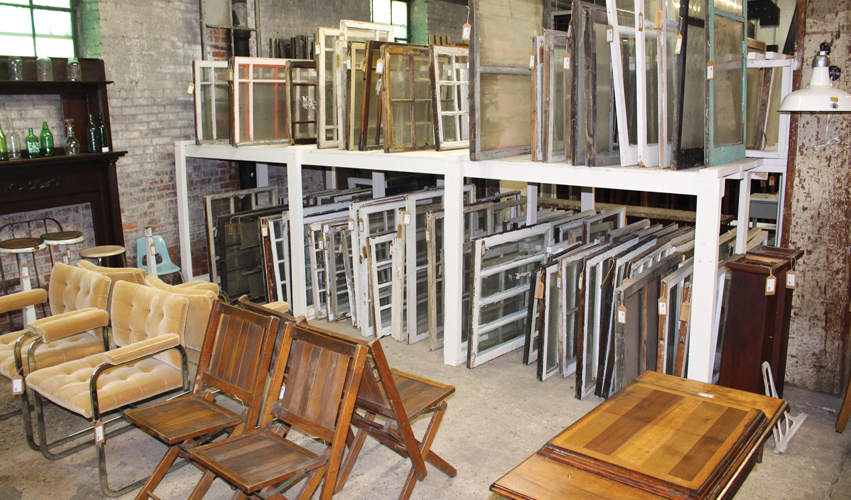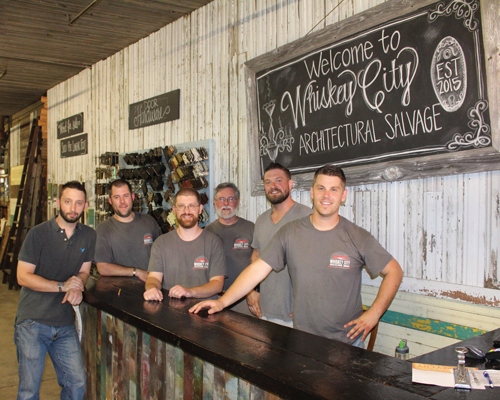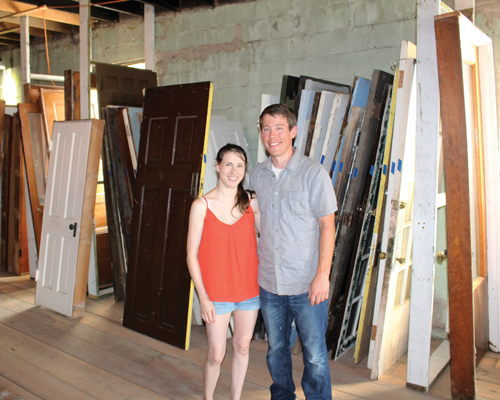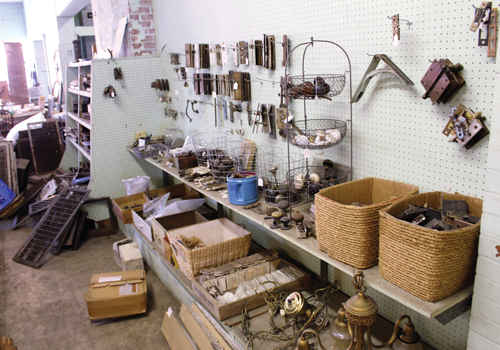
Two area companies are preserving the past at an affordable cost—and rescuing local architectural history in the process.
Beginning in the mid-20th century, the flight of many Americans to the suburbs helped create a seemingly irreversible process of urban decay. As tract housing and the infamous “McMansion” became ubiquitous across suburbia, older neighborhoods fell into disrepair, prompting inner-city property values to decline. While some communities managed to maintain these aging structures, time and the natural forces of decay have not been kind. The cost of repairs often necessitated the use of cheaper materials; thus, solid brass hardware was replaced with less-hardy zinc or aluminum, and hardwood flooring gave way to laminate. For many structures, this was not enough… and empty lots remain as ghostly markers of the demolished homes that once stood there.
In many cases, demolition is inevitable, but there is a silver lining: instead of dumping the remains of these homes into area landfills, those building materials can be salvaged and reused. A pair of relatively new businesses—Whiskey City Architectural Salvage and Peoria Architectural Salvage—are making it easier for central Illinois residents to do just that. Both companies are passionate about preserving the past at an affordable cost… and rescuing our local architectural history in the process.
 Whiskey City Architectural Salvage
Whiskey City Architectural Salvage
Bill Sullivan and Brennan Kennedy are the co-owners of Whiskey City Architectural Salvage, which opened its doors in May of this year. The two had long believed they first met as teenagers—but in a serendipitous moment a couple of years ago, they discovered their friendship extended much further back than either of them knew. Browsing through old belongings one day, Sullivan glanced at a newspaper clipping announcing his baptism and recognized a familiar name: his friend Brennan was listed alongside his own. “We were baptized in the same church and on the same day,” he laughs. “We met before we could even talk!”
In a way, this act of rummaging through old belongings foreshadowed the business venture the two friends would soon enter together. They began to discuss the gap in the architectural salvage market in the Peoria area; houses were being demolished and valuable materials were being thrown into landfills. “We did construction before, so we had a pretty good idea of how to use tools—but deconstruction is different,” Sullivan notes. “Every part of salvage is labor-intensive.” And because these are older structures, Kennedy adds, this labor is particularly challenging. “These homes were built to last for a long time.”
New to the industry, Sullivan traveled across the country to look at other salvage shops and gather ideas to incorporate into their storefront. “I have been to a lot of salvage stores that are really cluttered. You can’t get through the aisles, and I didn’t want that here,” he explains. “I wanted it to be very organized and easy for the consumer to come in and see exactly what price they would be paying for each item.”
They certainly achieved this goal—at their 4,500-square-foot space in Peoria’s Warehouse District, Whiskey City Architectural Salvage sports a clean, modern-rustic vibe. The shop has two showrooms featuring antique and upcycled items, ranging from Caterpillar memorabilia to vintage stainless-steel coffee and tea canisters. Customers can look through bins neatly marked with their contents—from glass slides and spindles to doorknobs and switch plate covers—and samples of the salvaged wood currently in stock are hung like garland on a wall, allowing clients to quickly identify their options. Pointing at one of the samples, Sullivan notes, “Because all of the wood we sell is per linear foot, it is easy for a customer to come in and say that they need six feet of this board… and it’s just that price time six.”

In addition, Sullivan and Kennedy teamed up with another local company, Rustic By Design, to offer customized furniture options. “I wanted to partner with woodworkers who could build items out of rustic materials,” Sullivan explains. At their “Design Your Own Table” station, customers can mix and match elements for a custom table from pre-selected salvaged materials. “You can literally pick out a leg style and a top style and have a semi-custom table at a predetermined price,” he adds. “And it’s all high-quality. It’s hard to find something like this at a reasonable price—and I think we may be the only option for something like this in Peoria.”
While they sometimes work with municipalities, the two say the majority of their salvage opportunities are the result of property owners reaching out to them. “A lot of it is word of mouth. People will come into the shop and tell us they have a barn or house available to salvage. But we’re really limited in the space we have here,” Sullivan explains.
And because they are flooded with offers, they have to be selective. “There are a lot of collectors who just want to get rid of stuff they’ve collected over the years, but they want a pretty penny for it,” Kennedy notes. “But we have to be able to sell it at a reasonable price—that people around here are willing to pay.”
At the end of the day, Sullivan and Kennedy say they find true joy in preserving pieces of Peoria’s history. Recently, the pair discovered glass negative plates in an attic space; upon closer inspection, they realized the negatives contained pictures of the home from its earliest years. “Everything has a story… and it is really important to us to pass that along,” Sullivan notes.
As they look to the future, they hope to offer more of their products online. Until then, they are taking it one day at a time. “Sometimes things come to Peoria without support,” Sullivan observes. “But it’s been really good for us so far.”
 Peoria Architectural Salvage
Peoria Architectural Salvage
Tom and Jeanine Wester never planned on running an architectural salvage business. But when they purchased an old home, the unexpected occurred: they discovered a passion for restoration work. “I fell in love with the ‘old-house’ vibe,” Jeanine laughs. The Wester’s home had been divided into apartment units; old doors had been torn out and all of the original hardware had been replaced. “There were duct-tape fixes on everything,” she explains. “So, we started fixing it back up. We wanted to look for appropriate, authentic materials… but we couldn’t even find a single door in Peoria, let alone one that would fit our door frames.”
On a visit to the Old House Society in Bloomington, the Westers found everything they needed. “We started thinking, Why isn’t there one of these in Peoria? It didn’t make sense,” Jeanine recalls. “They told us that we should think about opening a salvage business in Peoria.” Intrigued, the couple noticed that homes were being demolished near Peoria High School and decided to investigate salvaging opportunities. “We wondered what would happen to these houses, so we spoke to our councilperson and found out that once demolished, everything would go into a landfill,” she explains. “There are so many homes coming down and people don’t even think twice about it.”
Determined to end this wasteful cycle, the Westers worked with the City of Peoria to secure a contract to salvage materials from these homes. They acquired a 12,500-square-foot warehouse in the Warehouse District, where they currently store and sell all of their salvaged items. Tom works with four part-time staff members to salvage the materials, while Jeanine deals with the majority of the sales and paperwork.
The two have a busy schedule—Tom is a full-time professor at Illinois Central College and they have three children under the age of five—but they somehow manage to make it work. “It has become a part of our lives,” Jeanine says. “You’ll find salvage on our kitchen table. Our son parrots what I’m saying all the time. He even talks about doorknobs!”
In the warehouse, one cannot help but notice the wide array of materials available—a treasure trove for any old-home enthusiast. “We have windows, doors, tin, barn wood, built-ins, hardware, a little bit of furniture, staircase pieces, old grates… pretty much anything you would need for an old house!” And the couple stresses that no request is too odd. To their surprise, small strike plates used in old locks are among their most coveted items. “People snap them up like crazy,” Jeanine says. “It’s fun to find the missing puzzle piece for people.”
And if they don’t have it, she adds, they can usually find it. Recently, they became aware of a home restoration project in Michigan. While salvaging another home, Jeanine noticed a doorknob—and realized it was a match for the Michigan house. “I knew right away that they would want it! I cleaned it up, packaged it and sent it out there. Now it’s a part of their home!”
Because the Westers have firsthand knowledge of the cost and time it takes to restore older homes, they knew they would have to keep their prices reasonable. “Architectural salvage can be expensive. I think everybody sees dollar signs when they see these items,” Jeanine notes. “But we want these materials to go back into homes… So we try to work with people who are doing projects in order to keep everything cost-effective.”

As demand for salvaged material grows, so does the darker side of the business. “Some landlords who rent older homes want to rip out the good materials and sell them for salvage,” Jeanine explains, “but we aren’t buyers for that.” The Westers believe this practice is counterproductive to neighborhood restoration. “We really want to see locals come in and buy material to put value back into their property,” she adds. “We want to see some of the old homes stabilized in neighborhoods... I recommend that they keep the materials in the homes—and keep it in the value of the home—rather than rip it out and make a few bucks!”
After amassing so much knowledge about salvaging and deconstruction, Tom Wester was recently asked to join the City of Peoria’s Historic Preservation Commission. He also leads a deconstruction certificate program at Illinois Central College for those interested in salvaging old materials. The certificate consists of seven credit-hours, and most students can complete the program in one semester.
Eventually, the Westers hope to offer deconstruction courses at Peoria Architectural Salvage, but for now, they are focused on growing their business. “We would like to scale to full deconstruction. There is so much material in the homes that we can’t get when we are just doing salvage,” Jeanine explains. Full deconstruction, unlike salvaging, involves completely dismantling a home. “Up to 80 percent of the materials are reusable… even the roofing! It is a really good use of resources.”
Though Peoria Architectural Salvage does not have a storefront, the Westers find that one is not needed. When potential customers contact them, the couple can let them know immediately if the items they seek are in stock. They can also follow their latest updates on Facebook and Instagram, or even purchase materials through their online store. “Salvage can be kind of tedious sometimes,” Jeanine admits. “But it is really exciting to see everything we get out of the houses… and very satisfying when someone tells you they found a match they have been looking forever to find!” iBi
Whiskey City Architectural Salvage, 1101 SW Washington in Peoria, is open on Saturdays from 9am to 4pm. For more information, find them on Facebook or call (309) 643-1692. Warehouse hours at Peoria Architectural Salvage are by appointment. To learn more, visit peoriasalvage.com or call (309) 643-4593.

